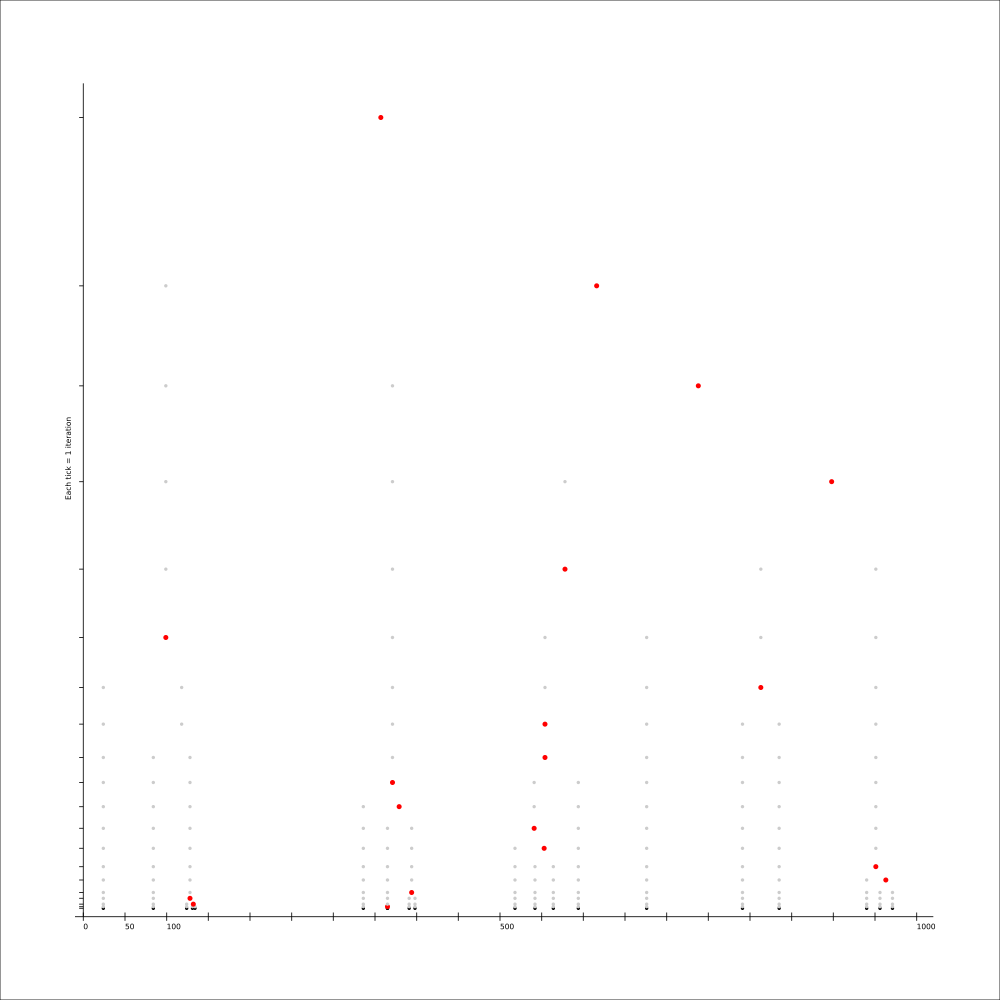While I first intended to create the matrices manually, it turned out to take too much time if I wanted to reproduce the exact same error as happened in the unit-tests.
So in order to create the matrices used in the earlier blog-posts, I used the script at the end of this article. I took care to double-check the results however. There are times, where there's a choice of more than one cluster to pick. And as the order is not important, this choice becomes dependent on the concrete implementation, and thus non-deterministic in the unit-tests. This caused a discrepancy in the matrices generated by the script below, and the current implementation of the algorithm in library. If that was the case, I validated the results manually, and they checked out.
Unfortunately though, the data in the existing unit-test do not provoke a difference between UCLUS and average linkage (there are no real outliers). Which is unfortunate. I will (for now) not create a new data-set to verify the difference between UCLUS and average. I trust the current implementation enough to say that it will do the right thing...
Finally, here's the script used to create the test-data:
from __future__ import print_function from difflib import SequenceMatcher def mean(numbers): """ Returns the arithmetic mean of a numeric list. see: http://mail.python.org/pipermail/python-list/2004-December/294990.html """ return float(sum(numbers)) / float(len(numbers)) def median(numbers): """ Return the median of the list of numbers. see: http://mail.python.org/pipermail/python-list/2004-December/294990.html """ # Sort the list and take the middle element. n = len(numbers) copy = sorted(numbers) if n & 1: # There is an odd number of elements return copy[n // 2] else: return (copy[n // 2 - 1] + copy[n // 2]) / 2.0 def textsim(x, y): sm = SequenceMatcher(lambda x: x in ". -", x, y) return 1 - sm.ratio() def simplesim(x, y): return abs(x-y) # sim = textsim sim = simplesim def single(a, b): return min([sim(ex, ey) for ex in a for ey in b]) def complete(a, b): return max([sim(ex, ey) for ex in a for ey in b]) def uclus(a, b): return median([sim(ex, ey) for ex in a for ey in b]) def average(a, b): return mean([sim(ex, ey) for ex in a for ey in b]) linkage = average data = [['Lorem'], ['ipsum'], ['dolor'], ['sit'], ['amet'], ['consectetuer'], ['adipiscing'], ['elit'], ['Ut'], ['elit'], ['Phasellus'], ['consequat'], ['ultricies'], ['mi'], ['Sed'], ['congue'], ['leo'], ['at'], ['neque'], ['Nullam']] data = [[_] for _ in [791, 956, 676, 124, 564, 84, 24, 365, 594, 940, 398, 971, 131, 365, 542, 336, 518, 835, 134, 391]] def matrix(data): for i, row in enumerate(data): for j, cell in enumerate(data[:i]): minsim = linkage(row, cell) yield (minsim, (i, j)) def step(data): while len(data) > 1: sorted_matrix = sorted(matrix(data), key=lambda x: x[0]) closest_items = sorted_matrix[0] a, b = closest_items[1] new_element = data.pop(max(a, b)) + data.pop(min(a, b)) data.append(new_element) return data def print_matrix2(data, iteration): values = [] for i, row in enumerate(data): simdata = [linkage(row, x) for x in data[:i]] values.extend(simdata) if values: smallest = min(values) print('.. csv-table:: Matrix #{}'.format(iteration)) print(' :header-rows: 1') print(' :stub-columns: 1') print(' :delim: :\n') print(' :' + ': '.join([', '.join([str(x) for x in _]) for _ in data])) for i, row in enumerate(data): simdata = [linkage(row, x) for x in data[:i]] strsimdata = ['**{:.3f}**'.format(_) if _ == smallest else '{:.3f}'.format(_) for _ in simdata] foo = ','.join([str(_) for _ in row]) bar = ': '.join(strsimdata) print(' ' + foo, bar, sep=': ') i = 1 while len(data) > 1: print_matrix2(data, i) print('\n') step(data) i += 1 print('\n') print_matrix2(data, i) print('\n')Comment

